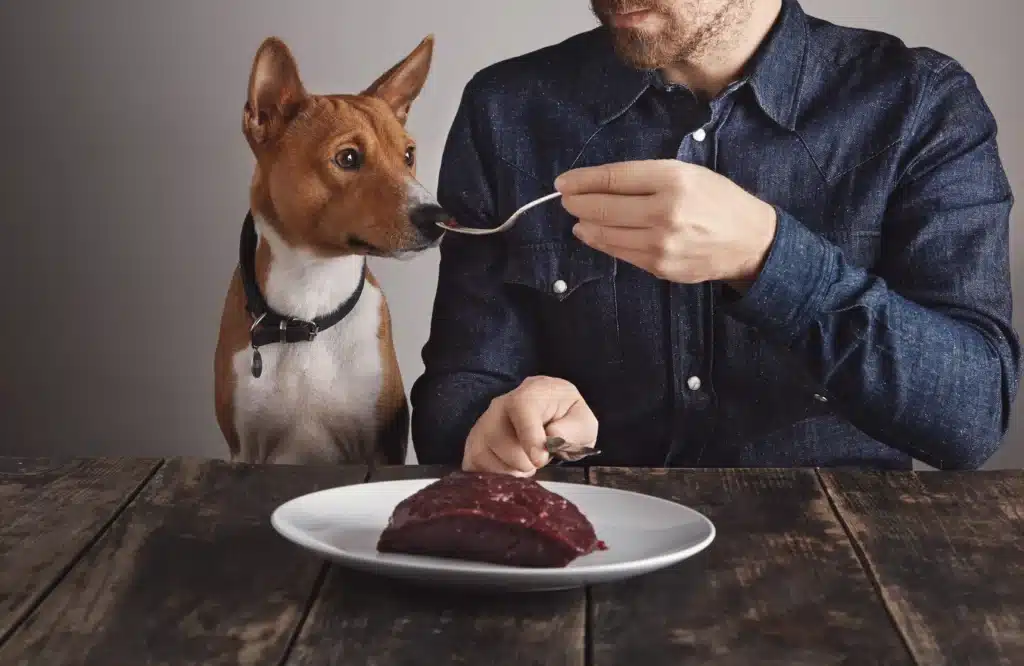What Is Chicken Liver Dog Food?
Chicken liver dog food refers to diets, toppers, or treats where chicken liver is a significant component. It’s prized because it offers concentrated protein, vitamins, and minerals that support canine health.
Commercial pet food brands sometimes use hydrolyzed chicken liver to improve flavor and digestibility for dogs with sensitivities.
Nutritional Profile: What’s Inside 100g of Cooked Chicken Liver
According to the USDA and related nutrition sources, 100 grams of simmered/cooked chicken liver provides approximately:
| Nutrient | Amount |
| Energy | 167 kcal |
| Protein | 24.5 g |
| Fat | ~6.5 g |
| Carbohydrates | ~0.87 g |
| Cholesterol | 563 mg |
| Iron | 11.6 mg |
| Phosphorus | 405 mg |
| Selenium | 82.4 µg |
| Vitamin A | 3,980 µg |
| Vitamin B-12 | ~16.8 µg |
| Vitamin C | 27.9 mg |
| Sodium | 76 mg |
| Water | 66.8 g |
Note: Raw chicken liver has different values (e.g. ~116 kcal, 16.9 g protein, 4.8 g fat).
This composition makes chicken liver extremely nutrient-dense — but also potent (especially in vitamins and cholesterol).
Benefits of Chicken Liver for Dogs
Because it’s so rich, adding chicken liver to a dog’s diet can offer:
- High-quality protein for muscle growth & repair
- Iron, B-12 & trace minerals for energy and red-blood-cell support
- Vitamin A & antioxidants for vision, immunity, and skin health
- Enhanced flavor & appetite stimulation, especially for picky eaters
- Low carbohydrate load, making it useful in some diabetic or low-glycemic diet plans
However, these benefits depend on serving size, preparation, and dog’s health status.
Risks, Toxicities & Safety Concerns
Vitamin A Toxicity
Liver is among the richest dietary sources of vitamin A. Over time, feeding too much can cause hypervitaminosis A, manifesting as bone pain, joint stiffness, weight loss, digestive issues, and even liver damage
Diagnosis may involve elevated liver enzymes and imaging of bones. Severely affected dogs may have irreversible damage.

Copper Overload
Certain breeds (e.g. Bedlington Terriers, Dobermans) are predisposed to copper-associated hepatitis. Because the liver contains copper, excess feeding can stress the liver and contribute to disease.
Digestive Upset
Sudden high doses of liver may lead to vomiting or diarrhea, especially in dogs not used to rich organ meats.
Bacterial / Food Safety Risks
Raw or undercooked chicken liver may carry Salmonella or Campylobacter. According to the USDA, chicken liver should be cooked fully to a safe internal temperature of 165 °F (73.9 °C) to mitigate pathogen risk. Also handle cross-contamination carefully in the kitchen.
Elevated Cholesterol
Because the liver is high in cholesterol (563 mg/100 g cooked), individuals with lipid sensitivities may need caution.
Safe Preparation & Serving Guidelines
Cooking Method
- Rinse fresh chicken liver, trim visible fat.
- Boil or steam without seasonings.
- Ensure internal temperature reaches 165 °F / 73.9 °C.
- Dice or cut into manageable pieces.
- Cool before serving.
- Store in fridge (≤ 2 days) or freeze (several weeks).
Portion Guidelines
A good rule: the liver should compose ≤ 5 % of a complete diet (by weight or calorie) — to maximize benefits and minimize toxicity risk.
Example portioning:
| Dog size | Liver per serving | Frequency |
| Small (10–20 lb) | ~15–30 g (½–1 oz) | 2–3× per week |
| Medium (20–50 lb) | ~30–45 g (1–1.5 oz) | 2–3× per week |
| Large (>50 lb) | ~60–75 g (2–2.5 oz) | ~2× per week |
If a commercial diet already contains liver or organ meats, reduce supplemental servings.
How to Use Chicken Liver in Your Dog’s Diet
- Topper / Garnish: Mix small chunks into kibble or wet food for flavor + nutrition.
- Ingredient in Homemade Diets: Use liver alongside lean protein, vegetables, and calcium under vet guidance.
- Freeze-Dried / Dehydrated Treats: These are concentrated — reduce quantity accordingly.
- Commercial Food Usage: Many pet food brands use hydrolyzed or liver powder precisely because it’s nutrient-dense and digestible.
FAQs of Chicken Liver Dog Food
Is liver good for dogs every day?
No — daily feeding risks vitamin A buildup. Use only 2–3 times per week.
Is raw chicken liver good for dogs?
Raw liver has nutrients, but also bacterial risk. Cooked is safer and nearly as beneficial.
Is cooked chicken liver good for dogs?
Yes — boiled or steamed liver is digestible, safe (if cooked fully), and retains vitamins.
What if a dog eats liver and gets diarrhea?
Stop feeding liver, switch to bland diet, and reintroduce slowly later.
Raw or cooked — which is better?
Cooked is recommended to avoid pathogens. If following a raw diet, ensure strict hygiene and vet supervision.
What are side effects of too much liver?
Bone/joint pain, liver damage, elevated cholesterol, copper overload, GI upset.
Is pork liver good for dogs every day?
Occasionally, yes — but pork liver is fattier and higher risk of contamination. Always cook thoroughly and feed sparingly.
Summary & Best Practices
- Chicken liver is one of the richest natural sources of protein, vitamins, and minerals for dogs — but its potency demands respect.
- Use it cooked, in moderation (≤ 5 % of diet), and aligned with your dog’s health, breed sensitivities, and existing food formula.
- Always observe your dog’s response and consult your veterinarian before major dietary changes.


